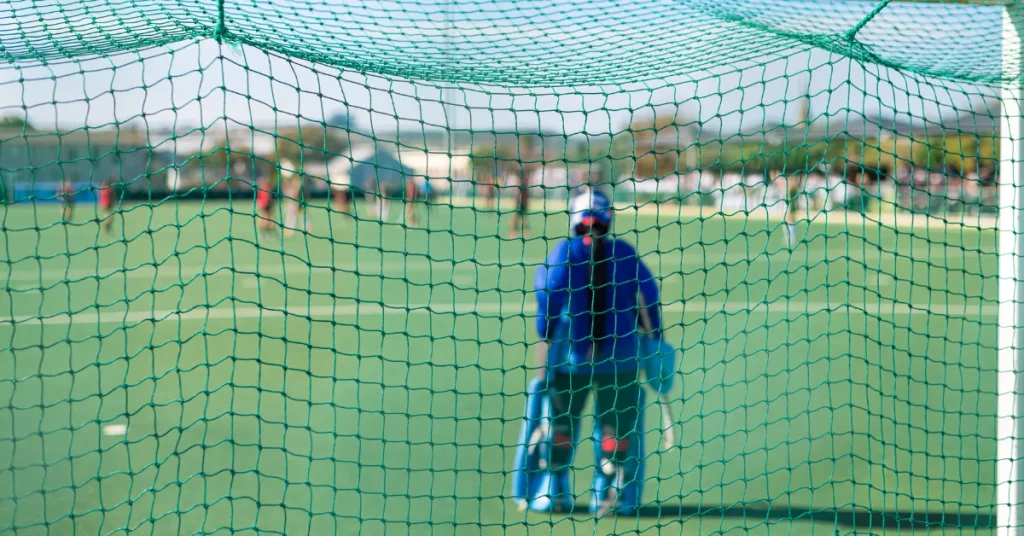A hockey net is 6 feet (1.83 meters) wide. Its height is 4 feet (1.22 meters).
Understanding the dimensions of a hockey net is crucial for players, coaches, and fans alike. The width and height are standardized to ensure uniform play across leagues and levels.
Whether you’re practicing your shots or gearing up for game day, knowing the target size helps in strategizing scoring techniques.
Enthusiasts keen on hockey statistics or equipment specifics will find these dimensions essential. Coaches integrate this knowledge into training sessions, emphasizing accuracy and precision.
Meanwhile, fans might use this information to appreciate the skill involved in scoring goals. Across the sport of hockey, the net’s width and height remain constants, integral to the heart-pounding excitement of the game.

Hockey Net Dimensions: The Standard
A hockey net stands as a pivotal point for scoring in the game. Knowing its dimensions is essential for players and fans alike. The standard hockey net dimensions ensure fair play and consistency across every rink. Let’s delve into the specifics of these measurements.
Regulation Sizes Across Leagues
Different leagues have their own standard sizes for hockey nets. The National Hockey League (NHL), International Ice Hockey Federation (IIHF), and amateur leagues follow set guidelines.
| League | Width | Height | Depth |
| NHL | 6 feet (72 inches) | 4 feet (48 inches) | 44 inches |
| IIHF | 6 feet (72 inches) | 4 feet (48 inches) | 44 inches |
| Amateur | 6 feet (72 inches) | 4 feet (48 inches) | Variable |
Most leagues share the 6 feet by 4 feet standard. This uniformity in size helps players adapt and excel at any level.
Impact Of Net Size On Gameplay
The size of the hockey net can greatly affect a game’s dynamic. A net’s width and height are crucial for goalies and shooters.
- Goalies need to cover the net’s expanse, demanding agility and reach.
- Shooters strategize to find the open areas within the net’s frame.
A well-sized net ensures a balance between offensive plays and defensive skills. It helps maintain the excitement and competitiveness of hockey.
History Of Net Size Evolution
The story of the hockey net is not just about a piece of equipment. It’s about the evolution of the game itself.
Over the years, as the sport of hockey has grown and changed, so has the size of its goals. Let’s dive into the history and explore how and why these changes came about.
Original Specs And Changes
When hockey first began, net sizes were not standardized. This led to a variety of goal sizes in early games. But in 1899, the Ontario Hockey Association took the first step in standardizing the net size. They set the goal dimensions at 4 feet high by 6 feet wide.
Since the original specification, there have been suggestions and trials to adjust the size. One change came during the 1990s, when the National Hockey League (NHL) experimented with increasing the net size to encourage more scoring.
This proposal, however, was met with mixed reactions and did not culminate in a permanent change.
| Year | Event | Net Size |
| 1899 | Standardization | 4′ x 6′ |
| 1990s | NHL Experiment | Proposed Increase |
Adaptations In Professional Hockey
In professional hockey, the standard NHL goal dimensions have remained constant. The critical nature of the net size in maintaining the integrity of the game is widely acknowledged by players, coaches, and officials alike.
Beyond dimensions, there have been adaptations in terms of design and materials used for better durability and puck visibility.
Frames evolved from wood to steel, and netting changed from heavy materials to nylon, reducing interference with the puck. In recent times, digital technology has been integrated to assist in goal verification processes, ensuring each goal scored is undisputable.
- Maintained 4 feet high by 6 feet wide
- Transition from wood to steel frames
- Shift to nylon netting
- Integration of goal verification technologies
Comparative Analysis: Hockey Vs. Other Sports

Welcome to our comparative analysis where we look at the size of the goal area across various sports. When comparing sports, a key element to consider is the size of the goal or net.
This feature impacts the style, rules, and difficulty of scoring in each game. Let’s delve into the dimensions of hockey goals and see how they stack up against other popular sports.
Goal Size In Hockey Vs. Soccer
In hockey, the goal is 4 feet high and 6 feet wide. On the other hand, a soccer goal is 8 feet high and 24 feet wide. This considerable difference changes how players approach scoring.
| Sport | Height | Width |
| Hockey | 4 feet | 6 feet |
| Soccer | 8 feet | 24 feet |
Net Variations In Ice Hockey And Field Hockey
Ice hockey and field hockey are similar but offer different experiences. The goal in ice hockey is the standard 4×6 feet. Field hockey’s goal is slightly larger, at 7 feet high and 12 feet wide.
- Ice Hockey Goal: 4 feet high by 6 feet wide
- Field Hockey Goal: 7 feet high by 12 feet wide
Manufacturing A Hockey Net
An ice hockey net serves as the main target for scoring goals. To ensure optimal play, precise manufacturing standards are vital.
We delve into the materials and design process, along with durability and safety considerations, showcasing the meticulous steps taken in crafting a hockey net for professional and recreational use.
Materials And Design
Quality materials create a resilient hockey net. Manufacturers typically use steel frames and nylon netting. The design follows standardized dimensions: 72 inches wide, 48 inches high, and 40 inches deep at the base.
| Component | Material | Standard Measurement |
| Frame | Steel | 2-inch Diameter |
| Netting | Nylon | 1.5-inch Mesh |
| Posts/Crossbar | Steel | 72 x 48 inches |
- Posts and crossbar require precision machining.
- Nets must withstand high-velocity impacts from pucks.
Durability And Safety Considerations
Every hockey net must stand up to rigorous use. Protective coatings on steel parts prevent rust. The nylon netting undergoes strength testing. All edges are smoothed to protect players.
- Frames receive a powder-coat finish.
- Nylon mesh is UV resistant to ensure longevity.
- Safety pads cover base and posts to prevent injury.
Proper welding and assembly guarantee stability. Regular safety inspections keep players secure. A strong, safe net enhances the hockey experience for everyone.
Influence Of Net Size On Training Regimens

The size of a hockey net can profoundly alter how players train. A standard hockey goal measures 6 feet wide by 4 feet tall.
Changes to these dimensions in practice sessions impact goalies and shooters differently. Specifically, trainers adjust drills to improve skills in various scenarios.
Goalie Drills And Strategies
Goalies need agility, reaction time, and positional awareness to excel. Smaller nets in training can sharpen these skills. Here are key drills:
- Close Quarters: Reducing the net’s width forces quicker reflexes as the goalie covers less area.
- Angle Play: With a full-size net, goalies learn to position themselves optimally to block potential shots.
- Rebound Control: Using a larger net in practice can teach goalies to direct the puck safely away from scoring zones.
Shooter Accuracy And Practice Techniques
Shooters rely on precision and power to get the puck past the goalie. Practice nets of various sizes can enhance these attributes. Check out these techniques:
- Target Shooting: Smaller nets demand higher accuracy, perfecting aim for game situations.
- Power Play: Regular nets during practice help shooters gauge the force needed to score from different distances.
- Deflection Drills: A larger net size can be used to practice tip-ins and redirects with more active space.
FAQs About How Wide Is A Hockey Net
How Many Feet Wide Is A Hockey Net?
A standard hockey net is 6 feet wide. This measurement is consistent across professional and amateur hockey leagues.
What Does Wide Of Net Mean In Hockey?
“Wide of the net” in hockey refers to a shot that misses the goal, failing to hit the net.
Did The Nhl Ever Change The Net Size?
Yes, the NHL adjusted the net size in 2013, slightly decreasing the depth to allow for more space behind the net.
How Far Apart Are The Nets In Hockey?
Hockey nets are positioned 200 feet apart from each other on a standard NHL rink.
Conclusion
Understanding the standard width of a hockey net enhances your appreciation for the skill required in the game. At 72 inches across, scoring goals is a testament to player precision.
Whether you’re a fan or a budding player, this knowledge deepens your hockey experience.
Grab your stick, aim sharp, and join the action.
Resources:
1. https://pelhamalabama.gov/1022/Hockey
